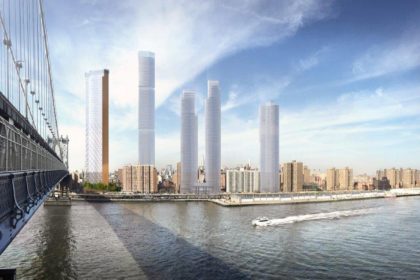Categories
Left column house ads
In the News: Ten Years of Marc Forgione
June 25, 2018 Crime, Real Estate, Restaurant/Bar News
••• Andrew Talks to Chefs interviews Marc Forgione: “a fun and free-ranging conversation with Chef Marc Forgione recorded recently at his eponymous restaurant in lower Manhattan. Andrew and Marc discuss the blessing/curse of being the son of a legendary chef; his formative days cooking for chefs such as Paticia Yeo and Laurent Tourondel; the origins and development of his restaurants Marc Forgione (which turns 10 this month), American Cut, and Khe-Yo; and what ‘New York food’ means to him. Oh, and they also get into the Forgione family’s premonitory gifts (seriously).”
••• “A Manhattan man who long ago transformed an unlivable Tribeca loft [at 329 Greenwich] into apartments owes nearly $1 million for squatting, the landlord claims. [The tenant] still lives in the front unit with his family for just $400 a month, claimed the landlord had never compensated him for the work he did in the building.” —New York Post
••• “The Nightclub King Whose Properties Were Harvey Weinstein’s ‘Hunting Ground’: Giuseppe Cipriani’s hotels, bars, and restaurants are synonymous with celebrity, and women say they are also where the movie mogul attacked them.” —Daily Beast
••• “The Uzbek national accused of killing eight people by driving a speeding truck along a New York City bike path last October spoke of a ‘war’ led by Islamic State at a pre-trial hearing on Friday and dismissed the court’s judgment as not important.” —New York Times
••• “Later today, the City Planning Commission is expected to certify a trio of skyscrapers in the Two Bridges section of the Lower East Side, setting of a two-month long public review process for developments that have faced stiff opposition from local residents and politicians.” The SHoP Architects rendering below shows the damage about to be done to the area north of the Manhattan Bridge. —Curbed
3 Comments
Comment:
Subscribe
Subscribe to the TC Newsletter












I think Robert Moses already destroyed the area north of the Manhattan Bridge in the 1960’s by flattening entire neighborhoods of 18th and 19th century buildings, and I suspect we can all admit at this point that some high-rise development there is overdue, and in general, some tasteful modern architecture (i.e., not bad 1960’s “projects”) would be a plus. The question is whether the new construction is done in a sensitive, tasteful way…and so far, that’s not been the case at all. The one tower they’ve put up is much too close to the bridge and sticks out like a sore thumb.
TriBeCa landlords were all for their completely ignored tenants fend for themselves for decades and now they want to kick them out…the article doesn’t suggest the family usurped any other space and essentially made the building livable.
The landlord should pay the tenant a million dollars worth of thanks for keeping his investment afloat. Many owners just abandoned their buildings in the 70’s.
The tenant is not entitled to a fixture fee for the 40-year old “improvements” he made in the apartment he was found to be trespassing in (hence the dispossession by the Court). As a trespasser, the tenant can be found liable in Court to pay the landlord for the value the tenant got from not paying rents (maybe even at market rates) all those years. See Sakele Bros. v. Safdie, 302 AD 2d 20 – NY: Appellate Div., 1st Dept. 2002 – (“We note that the proper measure of the damages for trespass is the gain the trespasser has derived from its wrongful conduct (see De Camp v Bullard, 159 NY 450, 454-455). The reason for this rule is that requiring a plaintiff to prove actual injury to recover more than nominal damages for trespass ‘would place a premium on trespassing’ by ‘mak[ing] the position of the trespasser more favorable than that of one lawfully contracting’ (id. at 454).”)
With respect to tenant’s alterations in the unit the tenant occupies lawfully, the Loft Law entitles a tenant to sell his fixtures on vacating to an incoming tenant, but he must offer them for sale to the Landlord first. It is not clear that the value he can collect is any more than the *depreciated* value of the improvements. His improvements from the 1970s are fully depreciated, given the long amount of time passed, and so the tenant is likely entitled to little for his legal improvements upon vacating.